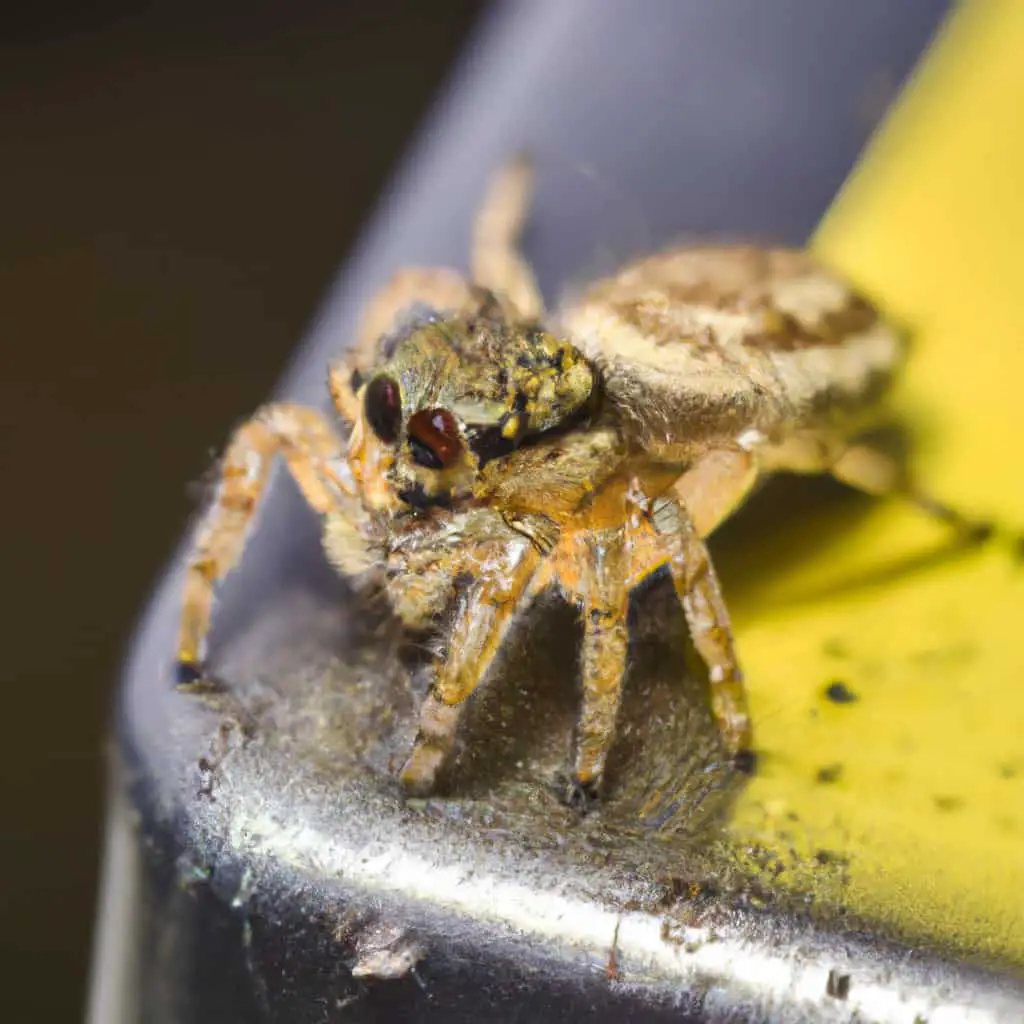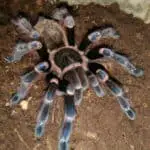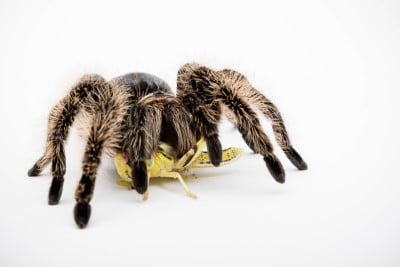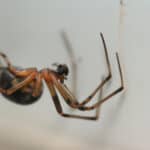Where can I buy a jumping spider? If you are looking to add a unique and fascinating pet to your collection, a jumping spider might be just what you need. These tiny arachnids are known for their incredible jumping ability, big eyes, and playful personalities. But where can you find them for sale?
There are several options for buying jumping spiders, including online pet stores, breeders, and hobbyists. It is important to do your research and find a reputable seller who can provide you with healthy and well-cared-for spiders. You will also want to consider the species of jumping spider you are interested in, as different types have unique care requirements.
Key Takeaways
- Jumping spiders can be purchased from online pet stores, breeders, and hobbyists
- It is important to find a reputable seller who can provide healthy spiders
- Consider the species of jumping spider and their care requirements before making a purchase

Understanding Jumping Spiders
Jumping spiders are fascinating creatures that are known for their unique ability to jump up to 50 times their body length in a single leap. As a spider enthusiast, I have come to appreciate these tiny arachnids for their playful and curious nature. In this section, I will provide an overview of jumping spiders, their size, life span, habitat, and temperature requirements.
Species Overview
Jumping spiders belong to the family Salticidae, which is one of the largest spider families in the world. There are over 5,000 known species of jumping spiders, with Phidippus being the most common genus. The Phidippus regius, also known as the regal jumping spider, is a popular species among pet owners due to its striking appearance and playful behavior.
Size and Life Span
Jumping spiders are relatively small, with most species measuring between 5 and 15 mm in length. Despite their small size, jumping spiders have a relatively long life span for their size, with some species living up to 3 years in captivity.
Habitat and Temperature Requirements
Jumping spiders are found all over the world, with most species preferring warm and humid climates. In the wild, jumping spiders can be found in a variety of habitats, including grasslands, forests, and deserts. As pets, jumping spiders require a habitat that mimics their natural environment. This includes a terrarium with plenty of hiding spots, a substrate that retains moisture, and a temperature range of 70-85°F.
In conclusion, jumping spiders are fascinating creatures that make great pets for spider enthusiasts. By understanding their size, life span, habitat, and temperature requirements, you can provide your pet jumping spider with the best possible care.
Caring for Jumping Spiders
Jumping spiders are fascinating creatures and can make great pets. As a responsible owner, it is important to provide proper care for your jumping spider to ensure its health and well-being. Here are some important things to keep in mind when caring for your jumping spider.
Feeding and Nutrition
Jumping spiders are carnivorous and require live prey to thrive. Crickets and house flies are great options for feeding your jumping spider. It is important to feed your spider twice a week to ensure it gets enough nutrients to stay healthy. Juvenile spiders may require more frequent feedings.
When feeding your spider, make sure to provide enough prey for it to eat but avoid overfeeding. Overfeeding can lead to obesity and other health issues. It is also important to remove any uneaten prey from the enclosure to prevent it from becoming a breeding ground for bacteria.
Proper Care and Molting
Jumping spiders are delicate creatures and require proper care to prevent stress and injury. While they can be interactive, it is important to limit handling to minimize stress and prevent accidental injuries. Jumping spiders molt regularly, shedding their old exoskeleton to grow a new one. During this time, they are vulnerable and should not be handled.
To provide proper care for your jumping spider, make sure to keep its enclosure clean and well-maintained. Mist the enclosure weekly to provide humidity and prevent dehydration. Decorate the enclosure with various surfaces to encourage exploration and exercise.
Breeding and Eggs
If you are interested in breeding your jumping spider, it is important to provide the proper environment and conditions. Male jumping spiders will perform a courtship dance to attract a female. Once they mate, the female will lay eggs in a cocoon.
It is important to remove the female from the enclosure once she lays her eggs to prevent her from eating them. The eggs will hatch in a few weeks, and the spiderlings will require special care and feeding.
Overall, caring for jumping spiders requires attention to detail and proper care. By providing a healthy environment and proper nutrition, you can ensure your jumping spider thrives and lives a long, healthy life.
Shopping for Jumping Spiders
If you are looking to buy a jumping spider, you have come to the right place. In this section, I will provide you with some tips on how to choose the right spider, understand shipping procedures, and payment options.
Choosing the Right Spider
When choosing a jumping spider, there are a few things to consider. First, make sure to research the different types of jumping spiders available. Each species has its own unique characteristics, such as size, color, and behavior. Consider what you are looking for in a spider and choose one that fits your preferences.
Second, make sure to buy from a reputable shop. Look for reviews and customer feedback to ensure that the shop you are buying from is trustworthy. You want to make sure that the spider you receive is healthy and well-cared for.
Understanding Shipping Procedures
Shipping procedures can vary depending on the shop you buy from. Make sure to read the shipping information carefully before making your purchase. Some shops may only ship on certain days of the week, while others may offer overnight shipping options.
It is also important to consider the weather when buying a jumping spider. Extreme temperatures can be harmful to the spider during shipping. Make sure to check the weather forecast and choose a shipping option that will ensure the spider arrives safely.
Payment Options
Most shops that sell jumping spiders accept major credit cards such as Mastercard, Visa, Discover, and American Express. Some shops may also accept other forms of payment, such as PayPal or cryptocurrency. Make sure to check the payment options before making your purchase.
In conclusion, buying a jumping spider can be a fun and rewarding experience. Make sure to do your research, choose a reputable shop, and understand the shipping procedures and payment options. With these tips in mind, you can find the perfect jumping spider to add to your collection.
Setting Up Your Spider’s Environment
When it comes to setting up your jumping spider’s environment, there are a few things you need to consider to ensure your spider stays healthy and happy. In this section, I will cover the key elements of setting up your spider’s environment, including choosing the right enclosure, selecting the substrate, and controlling temperature and humidity.
Choosing the Right Enclosure
The enclosure you choose for your jumping spider should be appropriate for its size and provide adequate ventilation. A minimum enclosure size of 10x10x15cm (or 4x4x6 inches) is recommended, but this can vary depending on the size and age of your spider. It’s important to research the specific jumping spider species you have to make sure the enclosure you’ve purchased is suitable.
Clear plastic containers with ventilation holes or small terrariums make great enclosures for jumping spiders. Make sure the enclosure is escape-proof and has a secure lid to prevent your spider from getting out.
Selecting the Substrate
The substrate you use in your jumping spider’s enclosure should be safe and comfortable for your spider. A good substrate should be able to hold moisture and provide a suitable surface for your spider to crawl on.
Some suitable substrates for jumping spiders include coconut fiber, sphagnum moss, and vermiculite. Avoid using substrates that can be harmful to your spider, such as sand or gravel.
Temperature and Humidity Control
Jumping spiders thrive in a warm and humid environment. The ideal temperature range for jumping spiders is between 28-32°C (82-89°F). You can achieve this temperature range by using a LED lamp or an Exo-terra Nano enclosure with a canopy as lighting.
To maintain the right humidity level, you can mist the enclosure with water once or twice a day. Avoid over-misting, as this can lead to mold growth and other issues.
In conclusion, setting up your jumping spider’s environment is crucial to its well-being. By choosing the right enclosure, substrate, and controlling the temperature and humidity, you can provide a safe and comfortable habitat for your spider to thrive in.
Additional Information
Common Concerns and Solutions
As with any pet, it’s important to consider common concerns and solutions when owning a jumping spider. Here are a few things to keep in mind:
- Experience: Jumping spiders are generally easy to care for, but it’s important to have some experience with arachnids before bringing one home.
- Products: Jumping spiders don’t require much in terms of products. A small container with good ventilation and a substrate of soil or coconut fiber is all they need.
- Web: Jumping spiders don’t make webs like other spiders. They rely on their excellent vision and jumping ability to catch prey.
- Insects: Jumping spiders eat insects, so it’s important to have a steady supply of fruit flies or other small insects on hand.
- Attack: Jumping spiders are not aggressive and rarely bite humans. If they do bite, it’s usually just a mild irritation.
- Sexing: It can be difficult to sex jumping spiders, especially when they are young. It’s best to buy from a reputable breeder who can provide you with a female if that’s what you’re looking for.
- Cocoons: Jumping spiders lay their eggs in small cocoons, which can be difficult to find. If you do find a cocoon, it’s best to leave it alone and let nature take its course.
- Field Collected: Field collected jumping spiders can be more difficult to care for than captive bred spiders. They may be stressed from their capture and may have parasites or diseases.
- Amphibians: Jumping spiders should not be kept with amphibians as they may try to eat them.
Understanding Spider Behavior
Jumping spiders are fascinating creatures with unique behavior. Here are a few things to keep in mind:
- Personality: Jumping spiders are known for their curious and friendly personalities. They may even seem to recognize their owners.
- Movement: Jumping spiders are agile and can move quickly. They are also excellent jumpers and can jump many times their body length.
- Hunting: Jumping spiders are active hunters and will stalk their prey before pouncing on it. They rely on their excellent vision to spot their prey.
- Mating: Jumping spiders have elaborate mating rituals that involve dancing and courtship displays. The male will often bring a gift of food to the female before mating.
- Female: Female jumping spiders are generally larger than males and may be more docile.
- Scorpions and Tarantulas: Jumping spiders should not be kept with scorpions or tarantulas as they may be seen as prey.
Resources for Further Learning
If you’re interested in learning more about jumping spiders, here are a few resources to check out:
- The Bugg Plug: This website offers captive bred jumping spiders for sale as well as information on their care.
- Itsy Bitsy’s Spiders: This breeder offers captive bred jumping spiders for sale and has a wealth of information on their care.
- Jumping Spiders for Sale: This pet store specializes in Phidippus jumping spiders and has a lot of information on their care.
- Arachnoboards: This forum has a section dedicated to jumping spiders where you can ask questions and learn from other owners.
- Jumping Spider Care Sheet: This care sheet from the Tarantula Forum has a lot of information on the care of jumping spiders.
Frequently Asked Questions
Where can I find exotic jumping spiders for sale?
If you’re looking for exotic jumping spiders, you can start by checking online pet stores or exotic pet breeders. You can also attend reptile and exotic pet expos, as they often have vendors selling a variety of invertebrates, including jumping spiders.
What is the average cost of a jumping spider?
The cost of a jumping spider can vary depending on the species and where you purchase it from. On average, you can expect to pay anywhere from $10 to $30 for a jumping spider.
Are jumping spiders good pets?
Jumping spiders can make great pets for those who are interested in invertebrates. They are active, curious, and have unique personalities. Plus, they require minimal space and can be easy to care for.
What is the best species of jumping spider to keep as a pet?
There are many different species of jumping spiders that can make great pets. Some popular species include the Regal Jumping Spider, the Bold Jumping Spider, and the Zebra Jumping Spider. It’s important to do your research and choose a species that fits your lifestyle and care abilities.
Where can I find a reputable jumping spider breeder?
You can find reputable jumping spider breeders online or at exotic pet expos. It’s important to do your research and choose a breeder who is knowledgeable about jumping spiders and takes good care of their animals.
What are the best places to buy jumping spiders?
You can buy jumping spiders from online pet stores, exotic pet breeders, or at reptile and exotic pet expos. It’s important to make sure you’re purchasing from a reputable source and that the spider you’re buying is healthy and well-cared for.








